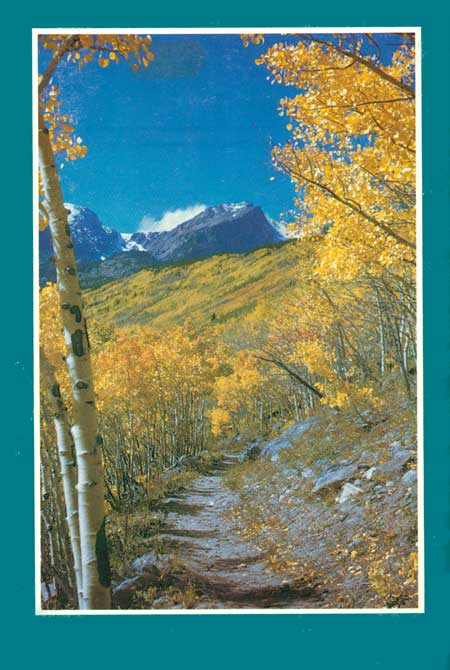|
Raising the Roof of the Rockies
A Geologic History of the Mountains and of the Ice Age in Rocky Mountain National Park |
ACKNOWLEDGMENTS
Necessarily, this history has been based on the work of many geologists who have discussed their observations and conclusions in hundreds of technical articles published in a wide variety of scientific journals. A few of these reports are listed below. No overall geological treatise on the Park has ever been published and several parts of the Park have never been studied in detail. Fortunately the region outside the Park in Colorado and Wyoming is being intensively investigated at present, and I wish to thank specifically Norman M. Denson, Glenn A. Izett, Estella B. Leopold, G. Edward Lewis, Glenn R. Scott, Richard B. Taylor, and Donald E. Trimble for generously contributing their knowledge and ideas, and for helpful criticism of the manuscript. To Richard B. Taylor belongs credit for the discovery that Specimen Mountain and adjacent ridges are capped by an ashflow tuff and that they are not the remains of an extinct volcano; also that the volcanic rock filling the ancient valley at Iceberg Lake is ashflow tuff rather than a rhyolite flow, as had been thought. The ages of the glaciations and interglaciations of the Ice Age are determined from the relations of correlative glacial and interglacial deposits in Yellowstone National Park to volcanic rocks dated by J. D. Obradovich. The 1.6-million-year-old glacial deposit in Yellowstone National Park was found and its relations determined by K. L. Pierce. Richard G. Baker is studying the pollen from deposits in Yellowstone National Park on which statements about the climate of the last interglacial—a time in question—are based. Personnel of the National Park Service have assisted materially through providing photographs and editing and arranging publication, especially Dwight L. Hamilton, Chief Park Naturalist, Rocky Mountain National Park, and Wayne Alcorn, N.P.S. (retired), who took many of the photos. Special thanks go to my wife, Amelie Z. Richmond, for her patience and help in all phases of preparation of the manuscript.
ABOUT THE AUTHOR
Gerald M. Richmond, a native of Rhode Island, received his bachelor of arts degree from Brown University, his master of arts degree from Harvard University, and his doctor of philosophy degree from the University of Colorado. He began his studies of the Rocky Mountains in 1938, in the Wind River Range of Wyoming. Following a year of work in the Canal Zone, he joined the U.S. Geological Survey in 1942. He has resided in Denver since 1946. His field of research, the Ice Age in the Rocky Mountains, has included studies in Rocky Mountain, Glacier, and Yellowstone National Parks. His publications comprise more than 70 professional reports and maps. A year of research in the Alps in 1961 resulted in a paper comparing the glacial stratigraphy of the Alps and Rocky Mountains. In 1965, he received the Geological Society of America Kirk Bryan Award for a paper on the Quaternary Stratigraphy of the La Sal Mountains, Utah. He has served as president of the Colorado Scientific Society, and was elected an Honorary Life Member in 1971. He has also served as chairman of the Division of Geomorphology and Glacial Geology of the Geological Society of America, as Secretary-General of the VII Congress of the International Union for Quaternary Research, held in Boulder, Colorado, in 1965, and as president of that International Union from 1965 to 1969. He is a Fellow of the Geological Society of America and active in other scientific organizations. In 1969 he initiated the organization of the American Association for Quaternary Research.

|
| BACK COVER: Hallett Peak viewed along Bierstadt Moraine. (Dwight L. Hamilton) |
ADMINISTRATION
Rocky Mountain National Park is administered by the National Park Service, U.S. Department of the Interior. A superintendent, whose address is Estes Park, Colo. 80517, is in immediate charge.
THE DEPARTMENT OF THE INTERIOR
As the Nation's principal conservation agency, the Department of the Interior has basic responsibilities for water, fish, wildlife, mineral, land, park, and recreational resources. Indian and Territorial affairs are other major concerns of America's "Department of Natural Resources." The Department works to assure the wisest choice in managing all our resources so each will make its full contribution to a better United States—now and in the future.
PRODUCTION CREDITS
Production Supervision Artcraft Printers, Inc., Bozeman, Montana, U.S.A.
| <<< Previous | <<< Contents >>> | Next >>> |
richmond/ack.htm
Last Updated: 8-May-2007